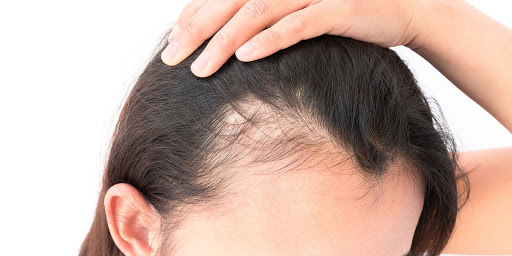Androgenetic alopecia is a common medical term that describes hair loss problems in both women and men. We also refer to this problem as male-pattern baldness and female pattern baldness for men and women, respectively.
Hair loss is a problem that may affect your entire body and not just your scalp. It develops due to several reasons, including hormonal changes, heredity, medications, and medical conditions. Baldness typically refers to when you have lost most of the hair on your scalp. The most common form of hair loss is hereditary, which occurs due to age progression.
Before deciding on a treatment to help combat your hair loss, it is important to discuss with your doctor. For example, they may have recommendations that will best suit your medical history.
Symptoms of Androgenetic Alopecia
Hair loss tends to take you by surprise, mostly depending on what is causing it. You may experience it happening unexpectedly, all of a sudden, or gradually. Hair loss may also only affect certain parts, such as your scalp or even your whole body. The process you see is unregulated and does not have a definite pattern. Certain types of hair loss tend to be permanent, while others are temporary.
Here are the symptoms of hair loss you will experience:
- The most common type is the gradual thinning of your hair on the top of your head. This particular type is common in both women and men as they age. Men experience forehead receding hairline that begins at the forehead. It occurs in a line, shaped like the letter M. Women generally retain the hairline on their foreheads. However, they experience a broadening in their hair parting.
- The next type is patchy or circular spots of baldness. This type of hair loss mainly affects the scalp. However, in rare cases, you may even notice it happening in the eyebrows or beard. In some extreme cases, people may also experience pain or itching of the skin before their hair starts falling out.
- The third type of hair loss consists of a sudden loosening. Often, emotional or physical shocks tend to loosen your hair. You may notice handfuls of your hair coming out when you comb or wash it. Even running your fingers through your hair ends may draw out a bunch. This type of hair loss usually causes overall thinning instead of bald patches.
- People also experience full-body hair loss quite often. Certain conditions may cause this, such as cancer chemotherapy, which causes hair from all over the body to fall out. However, this condition is generally temporary, and the hair eventually grows back.
- In some situations, people feel patches of scaling spread over their scalp. This may be a sign of ringworm. It often causes symptoms like redness, swelling, broken hair, and even oozing in some instances.
Causes of Androgenetic Alopecia
On average, people lose anywhere between 80 and 100 strands of hair each day. This usually does not cause noticeable hair thinning because new hair will also be growing simultaneously. Hair loss often occurs when something disrupts your cycle of hair growth. Another cause is when hair follicles suffer from damage but are replaced with scar tissue.
Typically, one or more of the following factors is usually responsible for hair loss:
- Medical conditions and hormonal changes- a variety of health conditions could cause you temporary or permanent hair loss, including hormonal changes in childbirth or pregnancy, thyroid problems, and menopause. Other medical conditions, such as hair infections like ringworm and alopecia areata, cause patchy hair loss and a hair-pulling disorder.
- The most common condition, as we already mentioned, is the hereditary condition. This occurs gradually as men and women age and in predictable terms. You will notice bald spots and receding in men and hair thinning in women.
- Supplements and medications may also be a cause. Drugs, such as the ones used for depression, cancer, heart problems, high blood pressure, arthritis, and gout, can cause side effects.
- Certain types of hairstyles can cause hair loss as well, such as cornrows, pigtails, or the ones that pull hair back tight. Excessive hairstyling can provoke a hair loss condition we refer to as traction alopecia.
- When people go through an emotional or physical shock, they may experience hair thinning as a consequence. This is a temporary hair loss situation.
Treatment
There are three recommended products to help treat androgenetic. Let’s discuss those:
Laser Caps
Laser caps for hair loss are a newer method on the market to regrow hair. These devices are FDA-cleared and proven to be safe and effective for men and women ages 18 and older to use. Laser caps use low-level laser (light) therapy to penetrate the tissue of the scalp. By doing this, blood flow is stimulated and encourages new cell growth in the hair follicles. This results in new hair growth in problematic areas, and thicker, stronger growth in areas that still contain hair.
Finasteride
Finasteride competitively inhibits an enzyme that converts the androgen testosterone into DHT. Experts recommend finasteride for treating androgenetic alopecia in men suffering from moderate to mild hair loss. Men may be experiencing this in the anterior mid-scalp or vortex area. However, the effects of this treatment vary based on the person using them.
Minoxidil
People use this topical product for hair growth. Minoxidil increases the cutaneous flow of blood to your resting hair follicles. Experts recommend Minoxidil for general thinning in your vortex. They do not recommend this agent for receding hairline or frontal baldness. Experts recommend Minoxidil at 2% strength for women, while both 5% and 2% strength are beneficial for men.
Conclusion
Several factors are responsible for androgenetic alopecia or hair loss in both men and women. You can take specific preventative measures to alter your situation. You can also try advanced products such as hair vitamins and other methods to revive new hair growth and prevent your hair loss problems from worsening.



